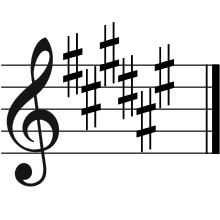D-sharp minor
 | |
| Relative key | F♯ major |
|---|---|
| Parallel key |
D♯ major enharmonic: E♭ major |
| Dominant key |
A♯ minor enharmonic: B♭ minor |
| Subdominant | G♯ minor |
| Enharmonic | E♭ minor |
| Component pitches | |
| D♯, E♯, F♯, G♯, A♯, B, C♯, D♯ | |
D-sharp minor or D♯ minor is a minor scale based on D-sharp, consisting of the pitches D♯, E♯, F♯, G♯, A♯, B, and C♯. For the harmonic minor, C![]() is used instead of C♯. Its key signature has six sharps.
is used instead of C♯. Its key signature has six sharps.
E♭ minor is its enharmonic equivalent. Its relative major is F♯ major (or enharmonically G♭ major), and its parallel major is D♯ major, usually replaced by E♭ major, since D♯ major's two double-sharps make it impractical to use.
Changes needed for the melodic and harmonic versions of the scale are written in with accidentals as necessary.
D♯ minor is infrequently used as the principal key center of pieces in the Classical era. More common is notation in E♭ minor, which is a relatively manageable key for many brass instruments and woodwinds.
Compositions in D-sharp minor
- The most famous work in this key is Scriabin's Etude Op. 8, No. 12.
- From Bach's Das Wohltemperierte Klavier, the eighth fugue from Book 1 and the eighth prelude and fugue from Book 2 are in D♯ minor; both fugues end with a Picardy third, requiring an F
 in the final D♯ major chord.
in the final D♯ major chord. - The Russian composer Lyapunov wrote the second étude of his Op. 11 set in the key, and also fifteen years later his Variations on a Russian Theme, Op. 49. In addition, his early Piano Concerto No. 1, Op. 4 was in the enharmonic key of E-flat minor.
- The second movement from Charles-Valentin Alkan's Grande sonate 'Les quatre âges', subtitled Quasi-Faust, is also in D-sharp minor (but ends in F-sharp major), and modulates into even sharper keys along the way, some even being theoretical keys, such as G-sharp major and E-sharp major.
- The hymn "O Sacrum Convivium" by Olivier Messiaen (1937) is in D-sharp minor.
In a few scores, 6-sharp key signatures in the bass clef are written with the sharp for the A on the top line.
Despite the key rarely being used in orchestral music other than to modulate, it is not entirely uncommon in keyboard music. For orchestration of piano music, some theorists recommend transposing the music to D minor or E minor. If D-sharp minor must absolutely be used, one should take care that B-flat wind instruments be notated in F minor, rather than E-sharp minor (or A instruments used instead, giving a transposed key of F-sharp minor), and E-flat instruments in C minor instead of B-sharp minor, in order to avoid double sharps in key signatures.
External links
 Media related to D-sharp minor at Wikimedia Commons
Media related to D-sharp minor at Wikimedia Commons
| Diatonic scales and keys | |||||||||||||||||||||||||||||||||||||||||||||||||||||||
|---|---|---|---|---|---|---|---|---|---|---|---|---|---|---|---|---|---|---|---|---|---|---|---|---|---|---|---|---|---|---|---|---|---|---|---|---|---|---|---|---|---|---|---|---|---|---|---|---|---|---|---|---|---|---|---|
 |
| ||||||||||||||||||||||||||||||||||||||||||||||||||||||
| The table indicates the number of sharps or flats in each scale. Minor scales are written in lower case. | |||||||||||||||||||||||||||||||||||||||||||||||||||||||